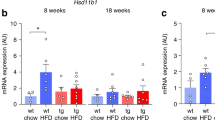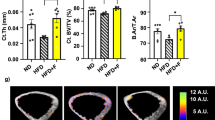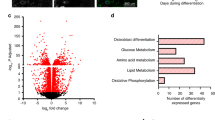Abstract
Obesity and impaired lipid metabolism increase circulating and local fatty acid (FA) levels. Our previous studies showed that a high high-saturated -fat diet induced greater bone loss in mice than a high high-unsaturated-fat diet due to increased osteoclast numbers and activity. The impact of elevated FA levels on osteoblasts is not yet clear. We induced obesity in 4 week old male mice using a palmitic acid (PA)- or oleic acid (OA)-enriched high fat high-fat diet (HFD) (20 % of calories from FA), and compared them to mice on a normal (R) caloric diet (10 % of calories from FA). We collected serum to determine FA and bone metabolism marker levels. Primary osteoblasts were isolated; cultured in PA, OA, or control (C) medium; and assessed for mineralization activity, gene expression, and ceramide levels. Obese animals in the PA and OA groups had significantly lower serum levels of bone formation markers P1NP and OC compared to normal weight animals (*p < 0.001), with the lowest marker levels in animals on an PA-enriched HFD (*p < 0.001). Accordingly, elevated levels of PA significantly reduced osteoblast mineralization activity in vitro (*p < 0.05). Elevated PA intake significantly increased C16 ceramide accumulation. This accumulation was preventable through inhibition of SPT2 (serine palmitoyl transferase 2) using myriocin. Elevated levels of PA reduce osteoblast function in vitro and bone formation markers in vivo. Our findings suggest that saturated PA can compromise bone health by affecting osteoblasts, and identify a potential mechanism through which obesity promotes bone loss.




Similar content being viewed by others
Abbreviations
- FA:
-
Fatty acid
- FFA:
-
Free fatty acid
- PA:
-
Palmitic acid
- OA:
-
Oleic acid
- HFD:
-
High fathigh-fat diet
- P1NP:
-
Procollagen type 1 N-terminal propeptide
- OC:
-
Osteocalcin
- SPT2:
-
Serine palmitoyl transferase 2
References
Rodan GA, Martin TJ (2000) Therapeutic approaches to bone diseases. Science (New York, N.Y.) 289:1508–1514
Boyle WJ, Simonet WS, Lacey DL (2003) Osteoclast differentiation and activation. Nature 423:337–342
Hannan MT, Felson DT, Anderson JJ (1992) Bone mineral density in elderly men and women: results from the Framingham osteoporosis study. J Bone Miner Res 7:547–553
Edelstein SL, Barrett-Connor E (1993) Relation between body size and bone mineral density in elderly men and women. Am J Epidemiol 138:160–169
Wosje KS, Khoury PR, Claytor RP, Copeland KA, Kalkwarf HJ, Daniels SR (2009) Adiposity and TV viewing are related to less bone accrual in young children. J Pediatr 154(79–85):e72
Pollock NK, Bernard PJ, Gutin B, Davis CL, Zhu H, Dong Y (2011) Adolescent obesity, bone mass, and cardiometabolic risk factors. J Pediatr 158:727–734
Kim JH, Choi HJ, Kim MJ, Shin CS, Cho NH (2011) Fat mass is negatively associated with bone mineral content in Koreans. Osteoporos Int 23:2009–2016
Greco EA, Fornari R, Rossi F, Santiemma V, Prossomariti G, Annoscia C, Aversa A, Brama M, Marini M, Donini LM, Spera G, Lenzi A, Lubrano C, Migliaccio S (2010) Is obesity protective for osteoporosis? Evaluation of bone mineral density in individuals with high body mass index. Int J Clin Pract 64:817–820
Fu X, Ma X, Lu H, He W, Wang Z, Zhu S (2011) Associations of fat mass and fat distribution with bone mineral density in pre- and postmenopausal Chinese women. Osteoporos Int 22:113–119
Hsu YH, Venners SA, Terwedow HA, Feng Y, Niu T, Li Z, Laird N, Brain JD, Cummings SR, Bouxsein ML, Rosen CJ, Xu X (2006) Relation of body composition, fat mass, and serum lipids to osteoporotic fractures and bone mineral density in Chinese men and women. Am J Clin Nutr 83:146–154
Ebbert JO, Jensen MD (2013) Fat depots, free fatty acids, and dyslipidemia. Nutrients 5:498–508
Campbell PJ, Carlson MG, Nurjhan N (1994) Fat metabolism in human obesity. Am Jo Physiol 266:E600–605
Listenberger LL, Han X, Lewis SE, Cases S, Farese RV Jr, Ory DS, Schaffer JE (2003) Triglyceride accumulation protects against fatty acid-induced lipotoxicity. Proc Natl Acad Sci USA 100:3077–3082
Koliwad SK, Streeper RS, Monetti M, Cornelissen I, Chan L, Terayama K, Naylor S, Rao M, Hubbard B, Farese RV Jr (2010) DGAT1-dependent triacylglycerol storage by macrophages protects mice from diet-induced insulin resistance and inflammation. J Clin Invest 120:756–767
DeFronzo RA (2010) Insulin resistance, lipotoxicity, type 2 diabetes and atherosclerosis: the missing links. The Claude Bernard Lecture 2009. Diabetologia 53:1270–1287
Samuel VT, Petersen KF, Shulman GI (2010) Lipid-induced insulin resistance: unravelling the mechanism. Lancet 375:2267–2277
Drosatos-Tampakaki Z, Drosatos K, Siegelin Y, Gong S, Khan S, Van Dyke T, Goldberg IJ, Schulze PC, Schulze-Spate U (2014) Palmitic acid and DGAT1 deficiency enhance osteoclastogenesis, while oleic acid-induced triglyceride formation prevents it. J Bone Miner Res 29:1183–1195
Titorencu I, Pruna V, Jinga VV, Simionescu M (2014) Osteoblast ontogeny and implications for bone pathology: an overview. Cell Tissue Res 355:23–33
Kotake S, Nanke Y (2014) Effect of TNFalpha on osteoblastogenesis from mesenchymal stem cells. Biochim Biophys Acta 1840:1209–1213
Yeh LC, Ford JJ, Lee JC, Adamo ML (2014) Palmitate attenuates osteoblast differentiation of fetal rat calvarial cells. Biochem Biophys Res Commun 450:777–781
Wong GL, Cohn DV (1975) Target cells in bone for parathormone and calcitonin are different: enrichment for each cell type by sequential digestion of mouse calvaria and selective adhesion to polymeric surfaces. Proc Natl Acad Sci USA 72:3167–3171
Drosatos K, Bharadwaj KG, Lymperopoulos A, Ikeda S, Khan R, Hu Y, Agarwal R, Yu S, Jiang H, Steinberg SF, Blaner WS, Koch WJ, Goldberg IJ (2011) Cardiomyocyte lipids impair beta-adrenergic receptor function via PKC activation. Am J Physiol 300:E489–499
Clugston RD, Jiang H, Lee MX, Piantedosi R, Yuen JJ, Ramakrishnan R, Lewis MJ, Gottesman ME, Huang LS, Goldberg IJ, Berk PD, Blaner WS (2011) Altered hepatic lipid metabolism in C57BL/6 mice fed alcohol: a targeted lipidomic and gene expression study. J Lipid Res 52:2021–2031
Kindt E, Wetterau J, Mueller SB, Castle C, Boustany-Kari CM (2010) Quantitative sphingosine measurement as a surrogate for total ceramide concentration-preclinical and potential translational applications. BMC 24:752–758
Bose R, Kolesnick R (2000) Measurement of ceramide levels by the diacylglycerol kinase reaction and by high-performance liquid chromatography–fluorescence spectrometry. In: John CR (ed) Methods in enzymology. Academic Press, Waltham, pp 373–378
Okere IC, Chandler MP, McElfresh TA, Rennison JH, Sharov V, Sabbah HN, Tserng KY, Hoit BD, Ernsberger P, Young ME, Stanley WC (2006) Differential effects of saturated and unsaturated fatty acid diets on cardiomyocyte apoptosis, adipose distribution, and serum leptin. Am J Physiol Heart Circ Physiol 291:H38–44
Lu ZH, Mu YM, Wang BA, Li XL, Lu JM, Li JY, Pan CY, Yanase T, Nawata H (2003) Saturated free fatty acids, palmitic acid and stearic acid, induce apoptosis by stimulation of ceramide generation in rat testicular Leydig cell. Biochem Biophys Res Commun 303:1002–1007
Morales A, Lee H, Goni FM, Kolesnick R, Fernandez-Checa JC (2007) Sphingolipids and cell death. Apoptosis Int J Program Cell Death 12:923–939
Glaros EN, Kim WS, Garner B (2010) Myriocin-mediated up-regulation of hepatocyte apoA-I synthesis is associated with ERK inhibition. Clin Sci (London, England: 1979) 118:727–736
Levy M, Futerman AH (2010) Mammalian ceramide synthases. IUBMB Life 62:347–356
Baylin A, Kabagambe EK, Siles X, Campos H (2002) Adipose tissue biomarkers of fatty acid intake. Am J Clin Nutr 76:750–757
Lu Y, Cheng J, Chen L, Li C, Chen G, Gui L, Shen B, Zhang Q (2015) Endoplasmic reticulum stress involved in high-fat diet and palmitic acid-induced vascular damages and fenofibrate intervention. Biochem Biophys Res Commun 458:1–7
Ardawi M-SM, Akhbar DH, AlShaikh A, Ahmed MM, Qari MH, Rouzi AA, Ali AY, Abdulrafee AA, Saeda MY (2013) Increased serum sclerostin and decreased serum IGF-1 are associated with vertebral fractures among postmenopausal women with type-2 diabetes. Bone 56:355–362
Hinton PS, Shankar K, Eaton LM, Scott Rector R (2015) Obesity-related changes in bone structural and material properties in hyperphagic OLETF rats and protection by voluntary wheel running. Metabolism 64:905–916
Wang JW, Tang QY, Ruan HJ, Cai W (2014) Relation between serum osteocalcin levels and body composition in obese children. J Pediatr Gastroenterol Nutr 58:729–732
Bao Y, Ma X, Yang R, Wang F, Hao Y, Dou J, He H, Jia W (2013) Inverse relationship between serum osteocalcin levels and visceral fat area in Chinese men. J Clin Endocrinol Metab 98:345–351
Hotamisligil GS, Shargill NS, Spiegelman BM (1993) Adipose expression of tumor necrosis factor-alpha: direct role in obesity-linked insulin resistance. Science (New York, N.Y.) 259:87–91
Listenberger LL, Ory DS, Schaffer JE (2001) Palmitate-induced apoptosis can occur through a ceramide-independent pathway. J Biol Chem 276:14890–14895
Cacicedo JM, Benjachareowong S, Chou E, Ruderman NB, Ido Y (2005) Palmitate-induced apoptosis in cultured bovine retinal pericytes: roles of NAD(P)H oxidase, oxidant stress, and ceramide. Diabetes 54:1838–1845
Elbaz A, Wu X, Rivas D, Gimble JM, Duque G (2010) Inhibition of fatty acid biosynthesis prevents adipocyte lipotoxicity on human osteoblasts in vitro. J Cell Mol Med 14:982–991
Pinto SN, Silva LC, Futerman AH, Prieto M (2011) Effect of ceramide structure on membrane biophysical properties: the role of acyl chain length and unsaturation. Biochim Biophys Acta 1808:2753–2760
Mehra VC, Jackson E, Zhang XM, Jiang XC, Dobrucki LW, Yu J, Bernatchez P, Sinusas AJ, Shulman GI, Sessa WC, Yarovinsky TO, Bender JR (2014) Ceramide-activated phosphatase mediates fatty acid-induced endothelial VEGF resistance and impaired angiogenesis. Am J Pathol 184:1562–1576
Hanada K (2003) Serine palmitoyltransferase, a key enzyme of sphingolipid metabolism. Biochim Biophys Acta 1632:16–30
Unger RH (2003) The physiology of cellular liporegulation. Annu Rev Physiol 65:333–347
Fernandez-Real JM, Bullo M, Moreno-Navarrete JM, Ricart W, Ros E, Estruch R, Salas-Salvado J (2012) A Mediterranean diet enriched with olive oil is associated with higher serum total osteocalcin levels in elderly men at high cardiovascular risk. J Clin Endocrinol Metab 97:3792–3798
Acknowledgments
The study was supported by the National Institute of Dental and Craniofacial Research-K08DE018968 and by the National Center for Advancing Translational Sciences, National Institutes of Health, through Grant Number UL1 TR000040.
Authors Contribution
Ulrike Schulze-Späte designed the study. Ahmad Alsahli, Kathryn Kiefhaber, Tziporah Gold, Munira Muluke, Hongfeng Jiang, and Serge Cremers contributed to experimental work and data analysis. Kathryn Kiefhaber and Ulrike Schulze-Späte prepared the first draft of the paper. Ahmad Alsahli, Kathryn Kiefhaber, Tziporah Gold, Munira Muluke, Hongfeng Jiang analyzed data, Ahmad Alsahli, Kathryn Kiefhaber, Tziporah Gold, Munira Muluke, Hongfeng Jiang, Serge Cremers, and Ulrike Schulze-Späte interpreted results, and Ulrike Schulze-Späte is guarantor. All authors revised the paper critically for intellectual content and approved the final version. All authors agree to be accountable for the work and to ensure that any questions relating to the accuracy and integrity of the paper are investigated and properly resolved.
Author information
Authors and Affiliations
Corresponding author
Ethics declarations
Conflict of Interest
The authors have no conflict of interest to declare.
Human and Animal Rights and Informed Consent
All applicable international, national, and/or institutional guidelines for the care and use of animals were followed. All procedures performed in studies involving animals were in accordance with the ethical standards of the institution or practice at which the studies were conducted.
Additional information
Ahmad Alsahli and Kathryn Kiefhaber have shared first co-authorship.
Electronic supplementary material
Below is the link to the electronic supplementary material.
Rights and permissions
About this article
Cite this article
Alsahli, A., Kiefhaber, K., Gold, T. et al. Palmitic Acid Reduces Circulating Bone Formation Markers in Obese Animals and Impairs Osteoblast Activity via C16-Ceramide Accumulation. Calcif Tissue Int 98, 511–519 (2016). https://doi.org/10.1007/s00223-015-0097-z
Received:
Accepted:
Published:
Issue Date:
DOI: https://doi.org/10.1007/s00223-015-0097-z




